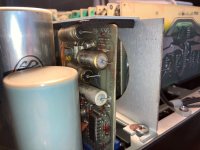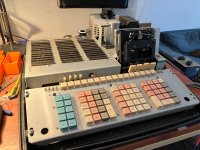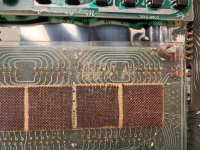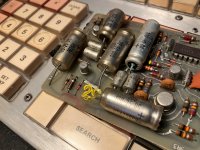BlaBla1985
Experienced Member
Over the coming weeks (months) I am going to attempt to bring a Wang Series 700B from 1971 back to full operation. I've had this machine for a few years now and even though it mostly seems to work, there are a couple of things that i know of that need doing. And i'd like to go over everything in one go now instead of having to tear the machine apart over and over.


I know that at least something in the power supply is out of spec, one of the caps is going a little crusty and it takes around 20 to 30 minutes of slowly turning up a Variac to power the machine up into a stable state. It will not run stable otherwise.

Another problem are the belts in the tapedrive, at least the main drive belt seems loose, and although the tape drive transport functions work and I can start the loading of a tape, it doesn't stop automaticly and it seems to load nothing. The playback seems a little jerky too so my first guess is the tape is not running smootly enough for the head to read the contents of the tape.
If anyone knows what belts the tapedrive take, i'm all ears.
There was also a little bit of crustiness visible on the memory board (no good picture of that yet but it did concern me a little)... The memory board does look pretty with it's core memory.

Any help, pointers or suggestions along the way will be very appriciated. This machine isn't like any other i have in my little collection and I'd like to learn as i go along with this project.
I got a lot of documentation with this machine, including some of the programs the original user wrote on paper (and possibly on storage tapes aswell).
The background of this machine: It was used by an engineer in a water treatment facility. I guess there much have been a lot more to the system then just the calculator, but only the calculator survived. I think when the machine became obsolete this engineer purchased/obtained it for private use. I bought the calculator with documentation from this engineers son after he passed away and the machine was found in the attic under it's dust cover. This means that the machine is really clean inside for it's age.


I know that at least something in the power supply is out of spec, one of the caps is going a little crusty and it takes around 20 to 30 minutes of slowly turning up a Variac to power the machine up into a stable state. It will not run stable otherwise.

Another problem are the belts in the tapedrive, at least the main drive belt seems loose, and although the tape drive transport functions work and I can start the loading of a tape, it doesn't stop automaticly and it seems to load nothing. The playback seems a little jerky too so my first guess is the tape is not running smootly enough for the head to read the contents of the tape.
If anyone knows what belts the tapedrive take, i'm all ears.
There was also a little bit of crustiness visible on the memory board (no good picture of that yet but it did concern me a little)... The memory board does look pretty with it's core memory.

Any help, pointers or suggestions along the way will be very appriciated. This machine isn't like any other i have in my little collection and I'd like to learn as i go along with this project.
I got a lot of documentation with this machine, including some of the programs the original user wrote on paper (and possibly on storage tapes aswell).
The background of this machine: It was used by an engineer in a water treatment facility. I guess there much have been a lot more to the system then just the calculator, but only the calculator survived. I think when the machine became obsolete this engineer purchased/obtained it for private use. I bought the calculator with documentation from this engineers son after he passed away and the machine was found in the attic under it's dust cover. This means that the machine is really clean inside for it's age.



